Telescope Reviews
Page 22
By Ed Ting
Updated 2/7/04
Click on a Telescope Below:
1) Celestron NexStar 114
2) Vixen VC200L
3) Orion 80 mm ED refractor
4) TeleVue 60
1) Celestron NexStar 114 10/10/03
(114 mm f/8.8 hybrid Newtonain, goto drive system, 25 mm, 10 mm eyepieces, tripod,
about $400 street)
Celestron is, as of this writing, revamping their entire line of telescopes, and as
a result, their remaining inventory is being blown out at various retailers around the
nation. I found this at a local Costco for about half the street price, and despite my
reservations about cheap goto-style scopes, I broke down and bought one (if you are
one of those unfortunate individuals and/or dealers that bought one before all this
happened, yes, I do feel for you.)
I would never have noticed this if I hadn't just reviewed it a month earlier, but the
entire optical tube assembly of this NexStar 114 is nearly identical in to the Orion
Starblast from the previous page. Astute readers will have noticed that the tube
seems way too short to accomodate a 1000 mm telescope. Yes, folks, this is
another one of Celestron's lens-in-the-focuser designs. Celestron brings out this
design from time to time, with mixed results. One of the latest was the G8N.
The build quality seems to be (mostly) decent, but there are some signs of cost-cutting.
There is a potentially annoying problem with the soft plastic bolt that holds the tray
to the tripod. You risk cross-threading the poor little bolt every time you use it (and
since the tray is designed to hold the hand controller, you will be using it.) Do yourself
a favor and buy a #10 X 1.5" bolt and some washers at your local hardware store. While
you're there, get some velcro and attach the battery pack to the fork arm so the scope
doesn't strangle itself with its own cord.
The optics are OK. At low power, there is some distortion around the edges. Due to the
addition of the relay lens, the star test was a little difficult to read. The optics appear
moderately undercorrected. The false color is not bad at all. I had the scope during
the latest Mars opposition and I could make out the polar cap, and some surface detail.
The optics work best when you keep the object in the sweet spot near the center of the
field of view. Let the object drift out towards the edges, and you start seeing some
problems.
I travel a lot in my job, and often wind up going to public restrooms and using the
electric air dryers. You know the ones I'm talking about, right? The ones with the three
steps to follow? Step 1): Push button. Step 2): Rub hands under warm air. Step 3):
Stops automatically.
Invariably, some joker winds up writing "Step 4): Wipe hands on pants!" underneath.
Cheap goto systems are a lot like that. After spending all the time initializing and
aligning the computer, you still sometimes wind up finding the objects by hand. To be
fair though, this sample is OK - it finds its targets about 90% of the time. There is a
tendency for the scope to become less accurate as the night goes on, however. The
other two owners of these NexStar 114s in our club report mostly positive results with
their tracking systems as well. But some of you out there have dutifully informed me how
bad the mounts and optics are on your NexStar 114s. (I have read the negative reivews
of this scope on the various newsgroups and forums out there. All I can say is, some of
you guys are mean!) In any case, there does seem to be a wide quality control variation
out there. Moral: save your receipt.
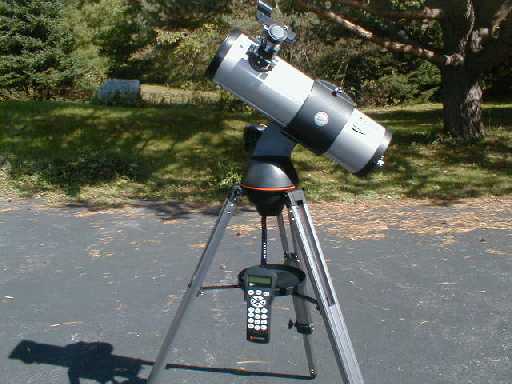 Wipe hands on pants? The NexStar 114
Once you're aligned, the scope seems to track reasonably well. I ran some controlled
tests on the tracking system. With fresh batteries (it is important that your batteries
are fresh) the scope will keep an object in a low power field of view for anywhere from
30 minutes to about an hour. If your batteries aren't topped off, or if you slew the scope
a lot, expect the accuracy to decrease over time. During a normal 2-3 hour observing
session, I found that I had to re-initialize the system about once an hour to get accurate
pointing and tracking.
I looked at most of the late summer and early fall Messier objects. The focuser is all
plastic, so be careful about stressing it with heavy eyepieces. The Veil (with an OIII
filter), Dumbbell, Ring, Swan, and Lagoon, nebulae are all easy. The faint fuzzies are a
little harder because the field isn't perfectly flat, and you wind up panning around a lot
to keep the view in the sweet spot. For reference, it will just barely see little NGC 6207
near M13 with the "10" eyepiece (of unspecified design.)
In short, the optics and mechanics are OK. I was reasonably happy with it for a while. But
any time I hauled out something else - anything else - the NexStar's limitations would become
apparent. A cheap 6" Dob will have better optics, and a sturdier mount, for example. So what
we have here is a telescope in that no-man's-land between "recommended" and "not recommended."
It is better than I expected, but no so good that I would want to use one every day.
2) Vixen VC200L 12/16/03
(200 mm 8" f/9 hybrid cassegrain OTA, diagonal, mounting plate, 20 mm Lanthanum eyepiece,
about $1450 street for OTA, about $2500 with GP-DX mount)
Although this scope has been around for a few years, it hasn't quite moved into the
mainstream of our hobby. I get requests from time to time to review it. Orion sold a
brand-labeled version for $1699 as late as 1998. Now that Vixen has apparently secured
more stable distribution in the US, we may start seeing more of these out in the field.
The older Orion units were white with black lettering. These new (I say "new" because the
word "NEW" appears right on the nameplate on the side of the tube) versions are dark
green.
The scope's design is unusual. The base design is a cassegrain, which Vixen describes
as a VISAC ("Vixen Sixth-Order Aspherical Catadioptric"). If you're looking for someone
to describe what that means, don't come running to me, because I don't understand it
either. There is a three-element corrector lens (of unspecified design) at the back
end of the scope, near the focuser. These lens-in-the-focuser designs have gotten a
bad rap recently, partly due to cheaply made imported telescopes. However, there is no
reason why this design can't work well (witness Takahashi's magnificent CN212, for example.)
Wipe hands on pants? The NexStar 114
Once you're aligned, the scope seems to track reasonably well. I ran some controlled
tests on the tracking system. With fresh batteries (it is important that your batteries
are fresh) the scope will keep an object in a low power field of view for anywhere from
30 minutes to about an hour. If your batteries aren't topped off, or if you slew the scope
a lot, expect the accuracy to decrease over time. During a normal 2-3 hour observing
session, I found that I had to re-initialize the system about once an hour to get accurate
pointing and tracking.
I looked at most of the late summer and early fall Messier objects. The focuser is all
plastic, so be careful about stressing it with heavy eyepieces. The Veil (with an OIII
filter), Dumbbell, Ring, Swan, and Lagoon, nebulae are all easy. The faint fuzzies are a
little harder because the field isn't perfectly flat, and you wind up panning around a lot
to keep the view in the sweet spot. For reference, it will just barely see little NGC 6207
near M13 with the "10" eyepiece (of unspecified design.)
In short, the optics and mechanics are OK. I was reasonably happy with it for a while. But
any time I hauled out something else - anything else - the NexStar's limitations would become
apparent. A cheap 6" Dob will have better optics, and a sturdier mount, for example. So what
we have here is a telescope in that no-man's-land between "recommended" and "not recommended."
It is better than I expected, but no so good that I would want to use one every day.
2) Vixen VC200L 12/16/03
(200 mm 8" f/9 hybrid cassegrain OTA, diagonal, mounting plate, 20 mm Lanthanum eyepiece,
about $1450 street for OTA, about $2500 with GP-DX mount)
Although this scope has been around for a few years, it hasn't quite moved into the
mainstream of our hobby. I get requests from time to time to review it. Orion sold a
brand-labeled version for $1699 as late as 1998. Now that Vixen has apparently secured
more stable distribution in the US, we may start seeing more of these out in the field.
The older Orion units were white with black lettering. These new (I say "new" because the
word "NEW" appears right on the nameplate on the side of the tube) versions are dark
green.
The scope's design is unusual. The base design is a cassegrain, which Vixen describes
as a VISAC ("Vixen Sixth-Order Aspherical Catadioptric"). If you're looking for someone
to describe what that means, don't come running to me, because I don't understand it
either. There is a three-element corrector lens (of unspecified design) at the back
end of the scope, near the focuser. These lens-in-the-focuser designs have gotten a
bad rap recently, partly due to cheaply made imported telescopes. However, there is no
reason why this design can't work well (witness Takahashi's magnificent CN212, for example.)
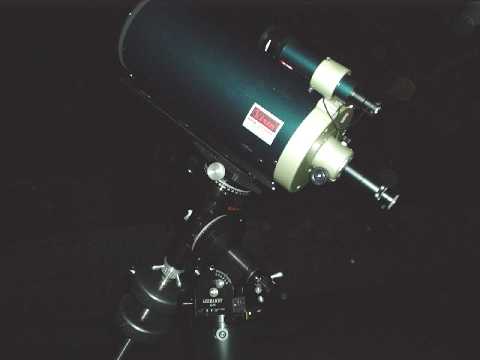 Vixen's VC200L at dusk (in 5 degree F NH weather)
Mount: Losmandy G11
In fact, catadioptric fans should take a close look at this scope, since it does offer a few
advantages compared to your standard issue Schmidt-Cassegrain. It costs more, but you
get a lot. The build quality is much better than most mass-produced SCTs. The Vixen has
a 2" rack and pinion focuser, which eliminates the primary image shift in an SCT. Also, the
scope is collimatable to an impressive degree - you not only get adjustment screws on the
secondary (which is all you get on most SCTs) but the primary has push-pull screws
too. You can even collimate the focuser. The f/9 focal ratio offers a slightly wider field,
and yields a slightly faster photographic system than conventional f/10 Schmidt-Cassegrains
(the scope is said to provide a perfectly flat image on a 35 mm film plane, with pinpoint
star images out to the edge.) Finally, there's no corrector plate to collect dew.
The scope is sold an an optical tube only, or with Vixen's GP-DX mount. I've seen the
scope sold online coupled to the lighter Great Polaris, but I think that's asking a lot of
a GP. You really do need something on the order of a GP-DX, or a Losmandy GM8 or G11.
There's a dovetail bar on the bottom of the scope that mates to any of the Vixen mounts.
The owner of this sample bought a Losmandy universal dovetail plate to mate it to his
G11. If you buy this telescope, try to be clear whether you get the finder, diagonal,
and 20 mm Lanthanum eyepiece (I've seen it "stripped" online to try to make the price
look lower. Be careful.) The visual back will accept a 2" diagonal. In addition to
the 7X50 finder, there is a bracket on the top with a 1/4" X 20 screw should you decide
to mount an additional finder/camera/etc. The bracket also serves as a carrying handle
(I'm not sure Vixen designed it this way, but everyone seems to use it as a handle.)
Vixen's VC200L at dusk (in 5 degree F NH weather)
Mount: Losmandy G11
In fact, catadioptric fans should take a close look at this scope, since it does offer a few
advantages compared to your standard issue Schmidt-Cassegrain. It costs more, but you
get a lot. The build quality is much better than most mass-produced SCTs. The Vixen has
a 2" rack and pinion focuser, which eliminates the primary image shift in an SCT. Also, the
scope is collimatable to an impressive degree - you not only get adjustment screws on the
secondary (which is all you get on most SCTs) but the primary has push-pull screws
too. You can even collimate the focuser. The f/9 focal ratio offers a slightly wider field,
and yields a slightly faster photographic system than conventional f/10 Schmidt-Cassegrains
(the scope is said to provide a perfectly flat image on a 35 mm film plane, with pinpoint
star images out to the edge.) Finally, there's no corrector plate to collect dew.
The scope is sold an an optical tube only, or with Vixen's GP-DX mount. I've seen the
scope sold online coupled to the lighter Great Polaris, but I think that's asking a lot of
a GP. You really do need something on the order of a GP-DX, or a Losmandy GM8 or G11.
There's a dovetail bar on the bottom of the scope that mates to any of the Vixen mounts.
The owner of this sample bought a Losmandy universal dovetail plate to mate it to his
G11. If you buy this telescope, try to be clear whether you get the finder, diagonal,
and 20 mm Lanthanum eyepiece (I've seen it "stripped" online to try to make the price
look lower. Be careful.) The visual back will accept a 2" diagonal. In addition to
the 7X50 finder, there is a bracket on the top with a 1/4" X 20 screw should you decide
to mount an additional finder/camera/etc. The bracket also serves as a carrying handle
(I'm not sure Vixen designed it this way, but everyone seems to use it as a handle.)
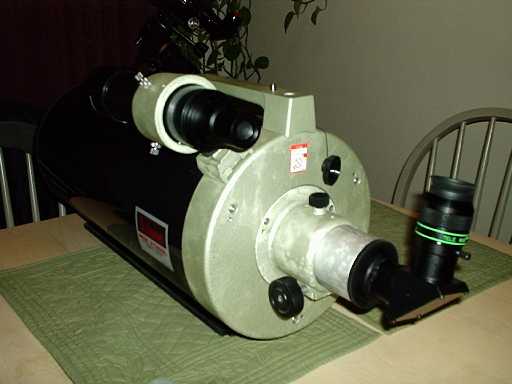 Close up of the back of the scope. Note (tiny)
collimation screws on primary cell and focuser
One concern with any scope using a corrector lens is false color. Vixen claims that for
all practical purposes there isn't any, and I'd have to agree. Even when the scope is
pushed to high powers on a bright star, I couldn't see any chromatic aberration. This
sample is slightly overcorrected, and arrived slightly out of collimation. The scope
was collimated and remained in collimation during the test period even after being driven
around in the back of a pickup truck. Stars are indeed pinpoints all the way out to the
edge of the field. The supplied 20 mm Lanthanum eyepiece is of very good quality, but the
field of view is a little narrow, and some might feel that 90X is a bit too high for general
purpose use. This isn't a big deal, since anyone in the market for a scope like this is
likely to own several good eyepieces already. However, if you're new at this, figure
on spending several hundred dollars for good eyepieces.
In practice, the scope performs like a nice Schmidt-Cassegrain with slightly lower power. After
a few minutes, you forget about the unusual design. We looked at many of the late fall and
early winter objects, including M103, M31, M15, the Ring, and the Dumbbell. We split a
couple of double stars, like the always-challenging Delta Cygnus, and Gamma Andromeda
(by the way, if anyone out there has split the .45 arc-second "B" component of Gamma Andromeda,
like in those Questar ads back in the 1980's, please write to me and tell me how you did it.)
Close up of the back of the scope. Note (tiny)
collimation screws on primary cell and focuser
One concern with any scope using a corrector lens is false color. Vixen claims that for
all practical purposes there isn't any, and I'd have to agree. Even when the scope is
pushed to high powers on a bright star, I couldn't see any chromatic aberration. This
sample is slightly overcorrected, and arrived slightly out of collimation. The scope
was collimated and remained in collimation during the test period even after being driven
around in the back of a pickup truck. Stars are indeed pinpoints all the way out to the
edge of the field. The supplied 20 mm Lanthanum eyepiece is of very good quality, but the
field of view is a little narrow, and some might feel that 90X is a bit too high for general
purpose use. This isn't a big deal, since anyone in the market for a scope like this is
likely to own several good eyepieces already. However, if you're new at this, figure
on spending several hundred dollars for good eyepieces.
In practice, the scope performs like a nice Schmidt-Cassegrain with slightly lower power. After
a few minutes, you forget about the unusual design. We looked at many of the late fall and
early winter objects, including M103, M31, M15, the Ring, and the Dumbbell. We split a
couple of double stars, like the always-challenging Delta Cygnus, and Gamma Andromeda
(by the way, if anyone out there has split the .45 arc-second "B" component of Gamma Andromeda,
like in those Questar ads back in the 1980's, please write to me and tell me how you did it.)
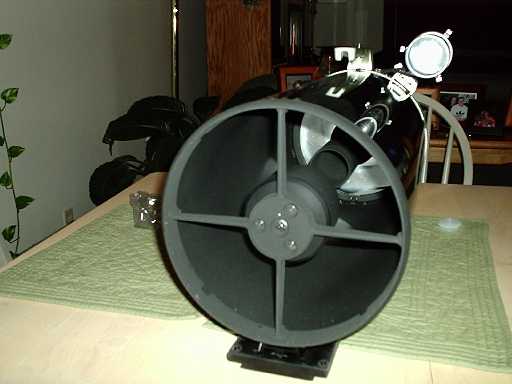 The front of the scope. The central obstruction is
about 1/3. Note thick secondary vanes (preferred by
many over thin ones.)
In polling club members about this scope, I kept getting the same two responses: 1) It's
a good telescope, and 2) It didn't leave much of an impression. The latter should be
taken as a compliment. When a scope doesn't leave an impression either way, it's a sign
that nothing is blatantly wrong (all too many scopes these days -especially cheap ones-
are leaving unwanted "impressions" on me.) Me, I like it when a scope gets out of the way
while I'm observing. In fact, if you buy one, your biggest problem is probably going to
be constantly having to explain to everyone how it works. Also, I have to point out that
at this price level, the scope is under serious competition from Celestron's wonderful
C9.25, which is fast becoming my favorite Schmidt-Cassegrain. You'll have to decide for
yourself whether you want the VC200L or the C9.25; they're both really good.
The front of the scope. The central obstruction is
about 1/3. Note thick secondary vanes (preferred by
many over thin ones.)
In polling club members about this scope, I kept getting the same two responses: 1) It's
a good telescope, and 2) It didn't leave much of an impression. The latter should be
taken as a compliment. When a scope doesn't leave an impression either way, it's a sign
that nothing is blatantly wrong (all too many scopes these days -especially cheap ones-
are leaving unwanted "impressions" on me.) Me, I like it when a scope gets out of the way
while I'm observing. In fact, if you buy one, your biggest problem is probably going to
be constantly having to explain to everyone how it works. Also, I have to point out that
at this price level, the scope is under serious competition from Celestron's wonderful
C9.25, which is fast becoming my favorite Schmidt-Cassegrain. You'll have to decide for
yourself whether you want the VC200L or the C9.25; they're both really good.
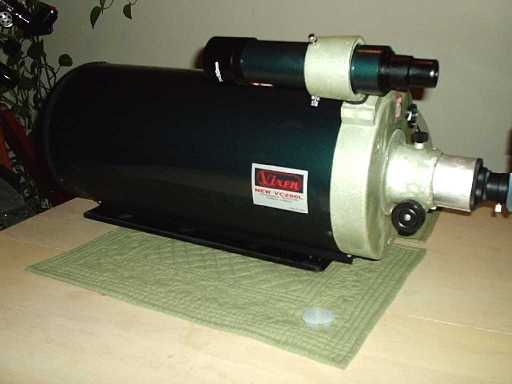 Side view of the scope. Note the word
"NEW" on the nameplate
Recommended for catadioptric lovers, for those who like to tinker, for serious photographers,
or for those who just enjoy having something a little different.
Vixen VC200L Hots:
Side view of the scope. Note the word
"NEW" on the nameplate
Recommended for catadioptric lovers, for those who like to tinker, for serious photographers,
or for those who just enjoy having something a little different.
Vixen VC200L Hots:
No image shift, no corrector plate
Collimation on primary, secondary, and focuser
Relatively inexpensive, high quality astrophoto tool
Costs less than a Takahashi CN212
Vixen VC200L Nots:
Not as "exciting" a telescope as you might think, based on its description
Costs more than a C8
You'll tire of constantly explaining to everyone how it works
I Reckon:
A solid performer that's off the beaten path
3) Orion 80 mm ED refractor 2/1/04
(80 mm f/7.5 ED apochromat, OTA only, $499)
My review of this telescope can be found in the Feb 2004 issue of Sky & Telescope.
If you want the full review, you'll have to go to your S&T, but the folks at Sky Publishing
are OK with me posting some brief comments here.
When I first heard about this scope, I was skeptical. Chinese apochromats, eh? As I
played with the samples (3 of them, in total) however, my skepticism changed to curiousity,
then to admiration. This is a wonderful scope, and a steal at the price (now raised to $499.)
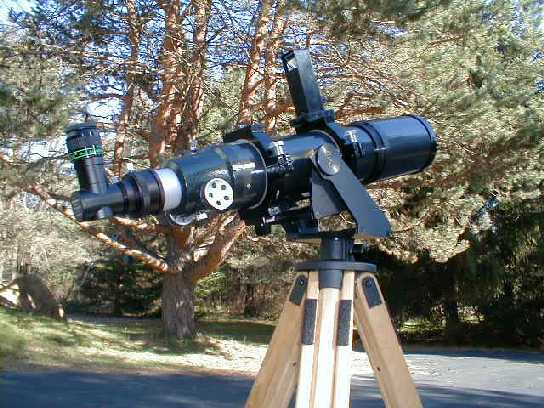 Orion's bargain apo on a TeleVue Gibraltar ($575) with Quik Finder ($40), Orion 1.25"
diagonal ($55), TeleVue 19 mm Panoptic ($250). Rings by Parallax ($125)
The scope is sold as an OTA only, so be prepared to outfit it with a finder, diagonal,
rings (the supplied 1/4" 20 threaded block isn't strong enough to support the scope),
and a mount. For the rings, use Orion's ($17) 100 mm rings, or the TeleVue clamshell
for their 4" scopes ($130.) For a mount, a Gibraltar or CG5/GP-class units will work
just fine.
In tests, the scope's optics were found to be similar to that of a TeleVue 76(!) with
only slight miscollimation noted on one sample (the S&T review also has a cool ronchi-
pattern on the objective's optics.) I could not see any color in any of the samples I
tested. Its images were obviously cleaner and "whiter" than those of any of the achromats
I tested alongside it. One particularly memorable observation: we split Delta Cygnus
with it. This is usually reserved as a test for a 4" telescope. The mechanics, while
not in the TeleVue class, are better than you'd expect, with a nice Crayford-style focuser.
Orion's bargain apo on a TeleVue Gibraltar ($575) with Quik Finder ($40), Orion 1.25"
diagonal ($55), TeleVue 19 mm Panoptic ($250). Rings by Parallax ($125)
The scope is sold as an OTA only, so be prepared to outfit it with a finder, diagonal,
rings (the supplied 1/4" 20 threaded block isn't strong enough to support the scope),
and a mount. For the rings, use Orion's ($17) 100 mm rings, or the TeleVue clamshell
for their 4" scopes ($130.) For a mount, a Gibraltar or CG5/GP-class units will work
just fine.
In tests, the scope's optics were found to be similar to that of a TeleVue 76(!) with
only slight miscollimation noted on one sample (the S&T review also has a cool ronchi-
pattern on the objective's optics.) I could not see any color in any of the samples I
tested. Its images were obviously cleaner and "whiter" than those of any of the achromats
I tested alongside it. One particularly memorable observation: we split Delta Cygnus
with it. This is usually reserved as a test for a 4" telescope. The mechanics, while
not in the TeleVue class, are better than you'd expect, with a nice Crayford-style focuser.
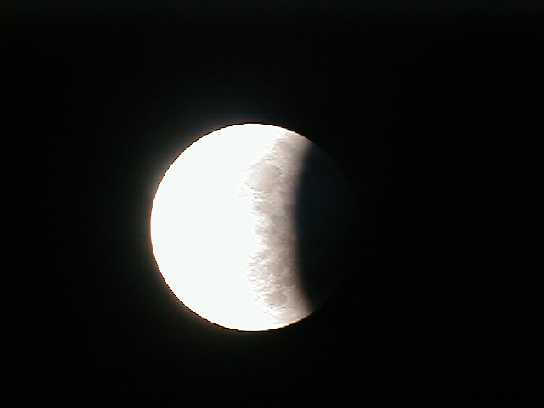 Photo of the Nov 8th lunar eclipse taken by the author through the Orion ED 80.
Note absence of false color at limb.
Camera: Olympus D340R, handheld in front of 10 mm TeleVue Radian eyepiece
This is a great bargain, and highly recommended.
Note: After the S&T review came out, a few of you have written to me about the focusers
on some of these ED80s. A very recent sample I saw had also had a minor issue with its
focuser. Briefly, on some samples, the focuser seems to stick a little when you try to
rack it in. Racking out is apparently not a problem. The problem seems to get worse
when you hang a lot of weight on the focuser (I didn't notice anything myself until I put
a 35 mm camera body on one sample.) I'm told the solution is to reseat the focuser
body by loosening the three screws that hold it on, and then tightening all three screws
by the same amount. In a couple of cases, people have had to reshim their focusers with
new teflon. Based on what I've seen, this is still to be considered a minor issue,
affecting only a few samples, and in any case Orion has an excellent return policy
should you experience any problems. The scope is still very highly recommended.
Intriguing thought: With this 3" apo such a success, can larger inexpensive Chinese
apochromats be far behind?
4) TeleVue 60 2/1/04
(60 mm f/6 apochromatic refractor, OTA, case, baseball cap, $795 street)
According to a local club member, there are two kinds of people in this world: Refractor Guys,
(it's always a guy, isn't it?) and everyone else. Refractor guys live to look through (and at)
their beloved and expensive lens-based telescopes. Refractor guys wouldn't trade one of
their scope for the biggest Newtonian out there. Think you're one of them? Take this
test: When you first saw ads for the TeleVue 60 a few months back, did you immediately
order one, sight unseen? If you did, congratulations, you're a Refractor Guy. You can
tell everyone I said so.
TeleVue's newest telescope is a cute little 60 mm f/6 apo. In a departure from their usual
styling, the TV60 has a sleek, tapered black body that resembles a spotting scope. It
weighs more than might think, looking at it. The construction is heavy-duty and very
serious. There's a sliding bar on the bottom that's very similar to the one on the Ranger.
Like the Ranger, it has a helical focuser and drawtube assembly. Unlike the Ranger, the
TV60 adds a nice sliding dew shield. I heard minor grumblings about the scope's thin
plastic lens cap - there's nothing wrong with it, it just seems a little cheap for such a
nice scope. You'll also have to supply your own diagonal and mount, but hey, you're
a Refractor Guy, so you've got plenty of spares hanging around, don't you?
Photo of the Nov 8th lunar eclipse taken by the author through the Orion ED 80.
Note absence of false color at limb.
Camera: Olympus D340R, handheld in front of 10 mm TeleVue Radian eyepiece
This is a great bargain, and highly recommended.
Note: After the S&T review came out, a few of you have written to me about the focusers
on some of these ED80s. A very recent sample I saw had also had a minor issue with its
focuser. Briefly, on some samples, the focuser seems to stick a little when you try to
rack it in. Racking out is apparently not a problem. The problem seems to get worse
when you hang a lot of weight on the focuser (I didn't notice anything myself until I put
a 35 mm camera body on one sample.) I'm told the solution is to reseat the focuser
body by loosening the three screws that hold it on, and then tightening all three screws
by the same amount. In a couple of cases, people have had to reshim their focusers with
new teflon. Based on what I've seen, this is still to be considered a minor issue,
affecting only a few samples, and in any case Orion has an excellent return policy
should you experience any problems. The scope is still very highly recommended.
Intriguing thought: With this 3" apo such a success, can larger inexpensive Chinese
apochromats be far behind?
4) TeleVue 60 2/1/04
(60 mm f/6 apochromatic refractor, OTA, case, baseball cap, $795 street)
According to a local club member, there are two kinds of people in this world: Refractor Guys,
(it's always a guy, isn't it?) and everyone else. Refractor guys live to look through (and at)
their beloved and expensive lens-based telescopes. Refractor guys wouldn't trade one of
their scope for the biggest Newtonian out there. Think you're one of them? Take this
test: When you first saw ads for the TeleVue 60 a few months back, did you immediately
order one, sight unseen? If you did, congratulations, you're a Refractor Guy. You can
tell everyone I said so.
TeleVue's newest telescope is a cute little 60 mm f/6 apo. In a departure from their usual
styling, the TV60 has a sleek, tapered black body that resembles a spotting scope. It
weighs more than might think, looking at it. The construction is heavy-duty and very
serious. There's a sliding bar on the bottom that's very similar to the one on the Ranger.
Like the Ranger, it has a helical focuser and drawtube assembly. Unlike the Ranger, the
TV60 adds a nice sliding dew shield. I heard minor grumblings about the scope's thin
plastic lens cap - there's nothing wrong with it, it just seems a little cheap for such a
nice scope. You'll also have to supply your own diagonal and mount, but hey, you're
a Refractor Guy, so you've got plenty of spares hanging around, don't you?
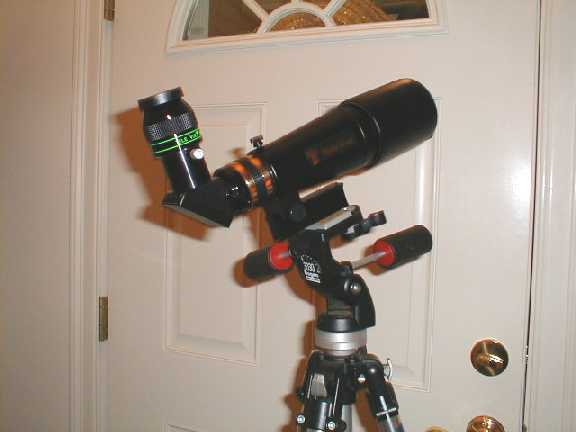 TeleVue's new baby refractor on a Bogen 3001/3030
Eyepiece: TeleVue 24 mm Panoptic ($300)
The scope has impressive optics. I caught a trace of undercorrection, nothing serious. No
false color was noted. At only 15X (with a 24 mm Panoptic) Titan could be seen as a tiny
pinpoint dot next to the planet. You can see Cassini's Division on Saturn at 70x (with a
5 mm Type 6 Nagler.) At the same 70X, I even caught Rhea in direct vision. The Trapezium
was easily resolved, with the Orion Nebula showing a faint trace of green. Castor is an
easy split. Most impressively, the scope split Rigel, again at 70X. On deep sky, you have
to make some allowances for the small aperture. M35 is just starting to resolve, but the
other nearby clusters (M37, M36, M38) look like similar faint smudges in the eyepiece. Not
exciting, but again, we're only talking about a 60 mm telescope here.
If you decide to use the scope as a luxury finder for something else, be aware that due to
the tapered body, you might have some difficulty finding a set of rings to fit it. You're
better off using the tapped holes in the sliding bar underneath. If you use the scope by
itself, any light mount will work. There doesn't seem to be any provision for mounting a
finder on it, but you probably won't need it - with a 24 mm Panoptic (15X), I never had
any trouble finding anything. I saw it used to good effect on the Universal Astronomics
Unistar Light. A photo tripod will work (I used my Bogen 3001/3030), or you could spring
for a Panoramic ($500). By the way, TeleVue has learned what more telescope companies
need to learn: Packaging a telescope with a few extras makes it more desirable. This is
especially true for cases. The inclusion of a case - any kind of case - increases the
perceived value of the telescope.
TeleVue's new baby refractor on a Bogen 3001/3030
Eyepiece: TeleVue 24 mm Panoptic ($300)
The scope has impressive optics. I caught a trace of undercorrection, nothing serious. No
false color was noted. At only 15X (with a 24 mm Panoptic) Titan could be seen as a tiny
pinpoint dot next to the planet. You can see Cassini's Division on Saturn at 70x (with a
5 mm Type 6 Nagler.) At the same 70X, I even caught Rhea in direct vision. The Trapezium
was easily resolved, with the Orion Nebula showing a faint trace of green. Castor is an
easy split. Most impressively, the scope split Rigel, again at 70X. On deep sky, you have
to make some allowances for the small aperture. M35 is just starting to resolve, but the
other nearby clusters (M37, M36, M38) look like similar faint smudges in the eyepiece. Not
exciting, but again, we're only talking about a 60 mm telescope here.
If you decide to use the scope as a luxury finder for something else, be aware that due to
the tapered body, you might have some difficulty finding a set of rings to fit it. You're
better off using the tapped holes in the sliding bar underneath. If you use the scope by
itself, any light mount will work. There doesn't seem to be any provision for mounting a
finder on it, but you probably won't need it - with a 24 mm Panoptic (15X), I never had
any trouble finding anything. I saw it used to good effect on the Universal Astronomics
Unistar Light. A photo tripod will work (I used my Bogen 3001/3030), or you could spring
for a Panoramic ($500). By the way, TeleVue has learned what more telescope companies
need to learn: Packaging a telescope with a few extras makes it more desirable. This is
especially true for cases. The inclusion of a case - any kind of case - increases the
perceived value of the telescope.
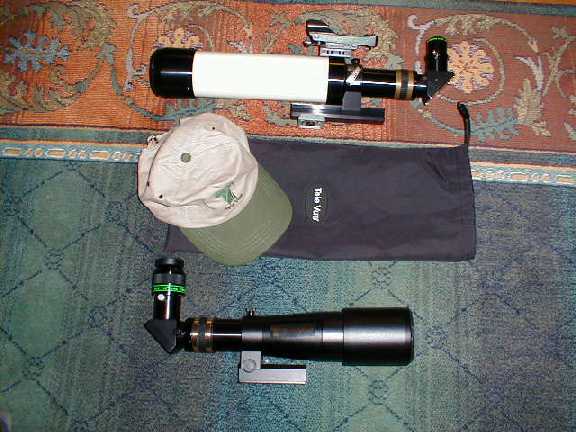 You mean I get a drawstring bag and a canvas TeleVue baseball
cap too? Sign me up! (Ranger at top for size reference.)
I once heard small scopes like this described as "One-Hour Telescopes." You get to see
pretty much everything you want to see in about an hour. As such, the TV60 is a great
quick peek or travel scope.
Should you get one? If you're a Big Dob Guy (which I suspect would be the spiritual opposite
of a Refractor Guy), and your personal idea of hell is standing behind some gutless little
apochromat for the evening, you should probably pass this one up. But if you're a true
Refractor Guy, you've probably already bought one and you're just reading this to check up
on me, right?
TeleVue 60 Hots:
Excellent optics and mechanics
Restores some credibility to the much-maligned 60 mm refractor
Drawstring bag, baseball cap!
TeleVue 60 Nots:
Not for aperture hounds
Not a good first scope
Cheap lens cap
I Reckon:
For quick peeks, or larger collections
Update, 2/7/04: TeleVue informs me that they plan to offer an X-Y heavy duty version of
their Starbeam mount, so that the TV60 can be mounted on a larger scope. Also, they
say the plastic lens cap was decided upon because it's lighter and cheaper, snaps on and
off more easily, and because it was felt that a metal dust cap might easily damage the lens
if the cap were to slip in the dark.
End Telescope Reviews, Page 22
You mean I get a drawstring bag and a canvas TeleVue baseball
cap too? Sign me up! (Ranger at top for size reference.)
I once heard small scopes like this described as "One-Hour Telescopes." You get to see
pretty much everything you want to see in about an hour. As such, the TV60 is a great
quick peek or travel scope.
Should you get one? If you're a Big Dob Guy (which I suspect would be the spiritual opposite
of a Refractor Guy), and your personal idea of hell is standing behind some gutless little
apochromat for the evening, you should probably pass this one up. But if you're a true
Refractor Guy, you've probably already bought one and you're just reading this to check up
on me, right?
TeleVue 60 Hots:
Excellent optics and mechanics
Restores some credibility to the much-maligned 60 mm refractor
Drawstring bag, baseball cap!
TeleVue 60 Nots:
Not for aperture hounds
Not a good first scope
Cheap lens cap
I Reckon:
For quick peeks, or larger collections
Update, 2/7/04: TeleVue informs me that they plan to offer an X-Y heavy duty version of
their Starbeam mount, so that the TV60 can be mounted on a larger scope. Also, they
say the plastic lens cap was decided upon because it's lighter and cheaper, snaps on and
off more easily, and because it was felt that a metal dust cap might easily damage the lens
if the cap were to slip in the dark.
End Telescope Reviews, Page 22
Back to Home Page
 Wipe hands on pants? The NexStar 114
Wipe hands on pants? The NexStar 114